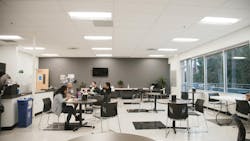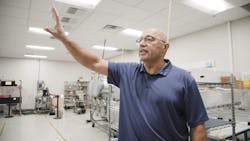Luminaire Level Lighting Controls: The Right Move for the Bottom Line?
On a clear day, people in cities north of Seattle glimpse the Cascade Mountains on their way to work. The snowcapped peaks stand as a constant reminder of the environmental wealth characterizing the Pacific Northwest. While beautiful, and seemingly robust, these natural resources are finite.
Facility administrators and managers in the region often approach energy efficiency not as a question of why, but as a matter of how. While perceived financial constraints can prevent needed technological upgrades, some sustainability-minded building professionals have discovered a close connection between cost savings and conservation.
That was the case for facility administrator Ken Packwood, whose job is to take care of his company’s expansive 74,000-square-foot manufacturing plant. He set out to identify and address the primary energy consumer in the building. Surprisingly, it was the existing lighting.
The How
Packwood started his research with YouTube, seeking guidance about lighting retrofits. He learned about luminaire level lighting controls (LLLC), a flexible system capable of automatically adjusting its output for diverse manufacturing needs and ensuring long-term savings in both dollars and kilowatt hours.
“I had to educate myself quite a bit, because lighting is not my forte,” he said. “But by doing some research online, I found other facility managers and made some calls.”
It became clear Packwood didn’t have to navigate this alone. On the other end of those phone calls were people in his industry who had already gone through networked lighting controls retrofits themselves.
Packwood’s networking eventually led to a new relationship with his local utility, Snohomish County PUD (SnoPUD). In their conversations, SnoPUD approached him with an offer to participate in their energy conservation program. John Petosa, senior program manager at SnoPUD, shared information about financial incentives as well as empirical data about LLLC, which can yield up to 75% energy savings compared to standard LED fixtures. The public utility provides these services because they know that many of their customers, like Packwood, aren’t lighting experts. It’s why SnoPUD connects their customers with a consultant through the Trade Ally Network NW, a free service sponsored by Bonneville Power Administration and its Northwest utilities.
“SnoPUD knows customers benefit from the complimentary expertise of Trade Ally Network NW consultants. They will help you develop an understanding of how our lighting retrofit program works and what your options are moving forward,” said Petosa.
The consultants advised Packwood on leveraging LLLC's programmable capacity to automate occupancy responses and reduce output in unoccupied workspaces. They also showed him how to adjust the system for time-of-use rates and demand response balances.
Packwood knew LLLC was the flexible solution his company needed, but he needed to convince his executive team of that, too.
The Case
The updated lighting system had a core feature Packwood wanted to convey to management, as it was the very philosophy that steers the company: reliability. Novanta, a global supplier of precision lasers for medical, industrial and microelectronic applications, prides itself on delivering exceptional performance. Executives are understandably protective of the company’s financial wellness and take corporate investments seriously—especially following COVID-19 and overseas supply chain issues that hit their bottom line hard.
The pandemic had also delayed the retrofitting project itself because of social distancing measures. All the while, Novanta’s outdated lighting system was increasingly in need of an upgrade.
“It took four years to roll the ball up the hill, but the final review came from an executive vice president from our corporate headquarters on the east coast,” said Packwood.
Packwood was ready. He, SnoPUD and the Trade Ally Network NW had created a profile showing the technological potential and readiness of LLLC for Novanta. They were also ready to clarify that LLLC's lighting investments help futureproof against inevitable changes. Rather than becoming obsolete as time passes, LLLC systems are adaptable and can be upgraded to provide new features.
Most importantly, Packwood and his partners knew LLLC would result in financial sustainability and provide dividends over the life of the system. They carefully calculated these projections and shared them in a forecast.
The value proposition offered was strong. SnoPUD could provide Novanta with $87,606 in incentives for LLLC fixtures, and the team estimated the return on investment for the entire project was around five years, meeting the company’s capital project requirements.
“The vice president knew I was no nonsense, and he knew he could trust the numbers I laid out,” said Packwood. “With the ROI calculation and incentive projections, it was just hard to say no.”
Management bought in.
The Results
While Novanta had hundreds of fixtures to replace, its installation was simple. A phased approach seamlessly took Packwood and his team through the setup. They put in nearly 700 fixtures, starting with 214 troffers networked via Lutron Vive and followed up with 478 Philips EvoKits. Packwood and his coworkers saw LLLC in action right out of the box.
LLLC’s integrated sensors provided unprecedented adaptability. It was exactly what Novanta needed, because the facility has both manufacturing floors and window-lit office spaces. The familiar, programmable and addressable nature of LLLC allowed Packwood to adjust for zones, light levels and behavior settings. He could optimize based on his coworkers’ various needs of different spaces.
LLLC has also simplified maintenance going into the future. Its system can be rezoned and reconfigured without wires, ladders or electricians.
Novanta expects to save $20,000 in electrical savings each year. Its annual reduction in total building energy use will come down to nearly 225,000 kWh. The significant cost and energy savings have made the Washington state facility a leader in the global company’s sustainability campaign. Packwood’s work is also the center of a new case study from BetterBricks, a commercial resource of the Northwest Energy Efficiency Alliance (NEEA).
Packwood is proud to share how he made an ethos so important to facility managers in the Pacific Northwest a reality—and how others can do it, too.
“From an environmental standpoint, this is the right move. We are saving energy. We are being more sustainable and wiser in our energy consumption and we’re getting a great return on our investment,” said Packwood. “I appreciate that I never have to change a light bulb again.”
About the Author
Angela Pilant
Angela Pilant has more than 25 years of experience working within the lighting and energy industries. She has a diverse background as a utility specialist, manufacturer’s representative, and consultant, working side by side with customers to upgrade their facilities with energy-efficient technology. She has worked at Evergreen Consulting Group since 2009 and specializes in market and trend analysis, utility program development, client engagement strategies, and training. Pilant is a certified instructor for the Building Operator Certification Program (BOC) and has developed and conducted cross-industry curriculum, including sales training, throughout the country. She has earned a Lighting Certified Professional designation from the National Council on Qualifications for the Lighting Professions (NCQLP).

